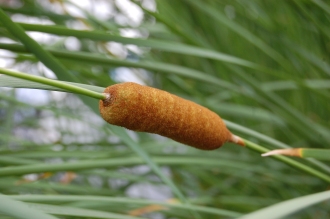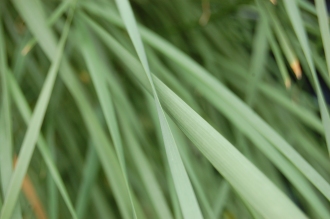Position: Full sun to partial shade
Flowering period: Mid summer to late autumn
Soil: Wet (planting depth 0cm to 150cm)
Eventual Height: 1.3m
Eventual Spread: 90cm
Hardiness: 3a, 3b, 4a, 4b, 5a, 5b, 6a, 6b, 7a, 7b, 8a, 8b 9a, 9b, 10a, 10b
Family: Typhaceae
Typha laxmannii is a deciduous, marginal, perennial, freshwater wetland plant with an arching habit. Its light green leaves are upright, strap shaped, are up to 4mm wide and 90cm long. Its brown flowers are monoecious with the female being distinctly separated from the male; female are cylindrical to ovoid, up to 30cm long and borne below the male on long flower stalks. The male which are slender and up to 1.5mm wide whither away once divested of pollen. Its fruit are borne densely upon the pistillate section. the roots of this plant are rhizomatous, which aids its spread.
Typha laxmannii, commonly known as Graceful Cattail or Narrow leaved European Cattail, is native to south west Asia and Europe. In its native habitat it grows in lakes, ponds, channels, swamps and shallow rivers.
The etymological root of the binomial name Typha is derived from the Greek name for this plant, ‘Tufh’. Laxmannii is named for Erik Gustavovich Laxmann (1737 – 1796), a Finnish clergyman, scientist and explorer.
The landscape architect may find Typha laxmannii useful for pond, streams and lake planting. This plant is suitable for use as part of a Sustainable Urban Drainage Systems (SUDS). It may used for planting in drainage ditches, swales and balancing ponds. It should be noted this species of Typha can be invasive, spreading by rhizomes.
Ecologically, Typha laxmannii provides food and nesting sites for waterfowl, marsh birds and small mammals.
Typha laxmannii prefers wet, fertile soils. It tolerates most pH of soil. It should be planted in water to a depth of 0cm to 150cm.
Typha laxmannii requires little maintenance. Large clumps may be divided in spring. Unwanted plants may be removed either mechanically or by the use of appropriate herbicide. Structures may be installed to prevent its unwanted spread.







Leave a comment